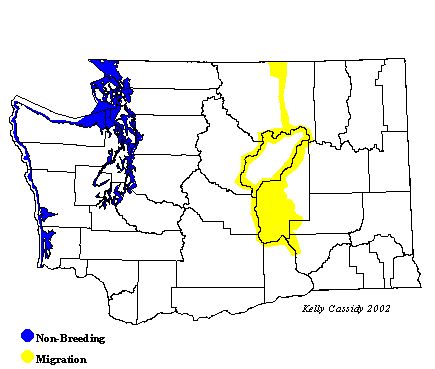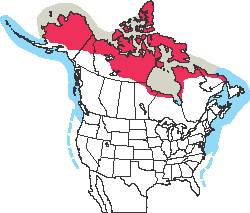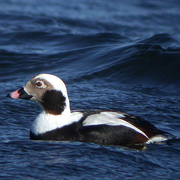Long-tailed Duck
General Description
Formerly known in the United States as the Oldsquaw, the Long-tailed Duck is a distinctive sea duck with a short bill and heavy body. The short, pointed, all-dark wings of the Long-tailed Duck are evident in all sexes and plumages. In breeding plumage, the male has a long, black tail-plume, a white rump and belly, and black breast. The head and back are black, with brown shoulders and a white patch around the eye. In winter the brown on the back is replaced by white, and the head is white with a gray cheek-patch. In spring, the female is gray with a white rump, and white around the eye and at the nape of the neck. In winter, she has a white face with dark crown and cheek-patch. The juvenile is similar to the female--gray with white, although it has more white on its face than the female.
Habitat
Long-tailed Ducks breed in shallow tundra ponds and lakes. During other seasons, Long-tailed Ducks can be found on the ocean over sandy substrates. They prefer sheltered water, but can be found on the open ocean as well.
Behavior
Long-tailed Ducks dive and swim under water, and, while they propel themselves with their feet like other ducks, their wings are sometimes partly opened under water. Most feeding is done within 30 feet of the surface, but they are capable of diving more than 200 feet below the surface. Long-tailed Ducks fly low with stiff and shallow wing-beats, often tilting from side to side.
Diet
For Long-tailed Ducks at sea, mollusks and crustaceans are the main source of food. In summer, aquatic insects, other aquatic invertebrates, and some plant material are eaten.
Nesting
Most female Long-tailed Ducks first breed at the age of two. Pair bonds are established in the winter, or during the spring migration, and last until incubation begins. The nest is located on dry ground close to the water, often hidden in the undergrowth or among rocks. It is a depression lined with plant material and great quantities of down that the female adds to the nest after she begins laying. She usually lays from 6 to 11 eggs and incubates them for 24 to 29 days. Shortly after hatching, the young leave the nest and can swim and dive well. The female tends them and may dislodge food items for them when she is diving, but they feed themselves. They first fly at 35 to 40 days.
Migration Status
Migration takes place late in the fall and early in the spring. Long-tailed Ducks may travel in large flocks and fly very high when going over land, although they usually migrate along coastlines. Migration may be a short distance from the inland breeding area straight out to the coast, or may be a long trip down the coastline. On the West Coast, however, the majority of the population winters in the Bering Sea.
Conservation Status
In the high Arctic, Long-tailed Ducks are often the most abundant bird, with a population in the millions. Such dense concentrations are vulnerable to oil spills and other contamination of the northern seas. When diving, many are caught in fishing nets and drown.
When and Where to Find in Washington
In Washington from mid-October to early May, Long-tailed Ducks are usually found in deep salt water, sometimes intermingled with scoters. They are common on the coast and in north Puget Sound, and are less common in the southern end of the sound. Large flocks can often be observed off Point Roberts and in Bellingham Bay. They have also been seen on ponds and lakes in eastern Washington and in the Okanogan Valley.
 Abundance
Abundance
| Ecoregion | Jan | Feb | Mar | Apr | May | Jun | Jul | Aug | Sep | Oct | Nov | Dec |
|---|---|---|---|---|---|---|---|---|---|---|---|---|
| Oceanic | ||||||||||||
| Pacific Northwest Coast | U | U | U | U | U | R | U | U | ||||
| Puget Trough | C | C | C | U | U | F | C | C | ||||
| North Cascades | ||||||||||||
| West Cascades | ||||||||||||
| East Cascades | ||||||||||||
| Okanogan | ||||||||||||
| Canadian Rockies | ||||||||||||
| Blue Mountains | ||||||||||||
| Columbia Plateau | R | R | R | R | R | R |
Washington Range Map

North American Range Map


Family Members
 Fulvous Whistling-DuckDendrocygna bicolor
Fulvous Whistling-DuckDendrocygna bicolor Taiga Bean-GooseAnser fabalis
Taiga Bean-GooseAnser fabalis Greater White-fronted GooseAnser albifrons
Greater White-fronted GooseAnser albifrons Emperor GooseChen canagica
Emperor GooseChen canagica Snow GooseChen caerulescens
Snow GooseChen caerulescens Ross's GooseChen rossii
Ross's GooseChen rossii BrantBranta bernicla
BrantBranta bernicla Cackling GooseBranta hutchinsii
Cackling GooseBranta hutchinsii Canada GooseBranta canadensis
Canada GooseBranta canadensis Mute SwanCygnus olor
Mute SwanCygnus olor Trumpeter SwanCygnus buccinator
Trumpeter SwanCygnus buccinator Tundra SwanCygnus columbianus
Tundra SwanCygnus columbianus Wood DuckAix sponsa
Wood DuckAix sponsa GadwallAnas strepera
GadwallAnas strepera Falcated DuckAnas falcata
Falcated DuckAnas falcata Eurasian WigeonAnas penelope
Eurasian WigeonAnas penelope American WigeonAnas americana
American WigeonAnas americana American Black DuckAnas rubripes
American Black DuckAnas rubripes MallardAnas platyrhynchos
MallardAnas platyrhynchos Blue-winged TealAnas discors
Blue-winged TealAnas discors Cinnamon TealAnas cyanoptera
Cinnamon TealAnas cyanoptera Northern ShovelerAnas clypeata
Northern ShovelerAnas clypeata Northern PintailAnas acuta
Northern PintailAnas acuta GarganeyAnas querquedula
GarganeyAnas querquedula Baikal TealAnas formosa
Baikal TealAnas formosa Green-winged TealAnas crecca
Green-winged TealAnas crecca CanvasbackAythya valisineria
CanvasbackAythya valisineria RedheadAythya americana
RedheadAythya americana Ring-necked DuckAythya collaris
Ring-necked DuckAythya collaris Tufted DuckAythya fuligula
Tufted DuckAythya fuligula Greater ScaupAythya marila
Greater ScaupAythya marila Lesser ScaupAythya affinis
Lesser ScaupAythya affinis Steller's EiderPolysticta stelleri
Steller's EiderPolysticta stelleri King EiderSomateria spectabilis
King EiderSomateria spectabilis Common EiderSomateria mollissima
Common EiderSomateria mollissima Harlequin DuckHistrionicus histrionicus
Harlequin DuckHistrionicus histrionicus Surf ScoterMelanitta perspicillata
Surf ScoterMelanitta perspicillata White-winged ScoterMelanitta fusca
White-winged ScoterMelanitta fusca Black ScoterMelanitta nigra
Black ScoterMelanitta nigra Long-tailed DuckClangula hyemalis
Long-tailed DuckClangula hyemalis BuffleheadBucephala albeola
BuffleheadBucephala albeola Common GoldeneyeBucephala clangula
Common GoldeneyeBucephala clangula Barrow's GoldeneyeBucephala islandica
Barrow's GoldeneyeBucephala islandica SmewMergellus albellus
SmewMergellus albellus Hooded MerganserLophodytes cucullatus
Hooded MerganserLophodytes cucullatus Common MerganserMergus merganser
Common MerganserMergus merganser Red-breasted MerganserMergus serrator
Red-breasted MerganserMergus serrator Ruddy DuckOxyura jamaicensis
Ruddy DuckOxyura jamaicensis

